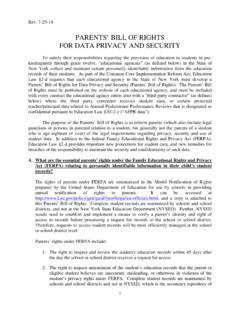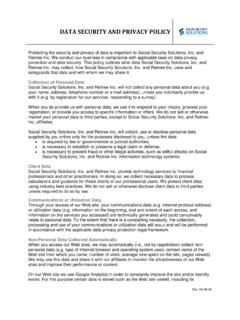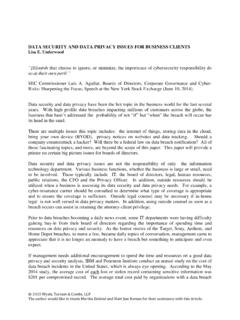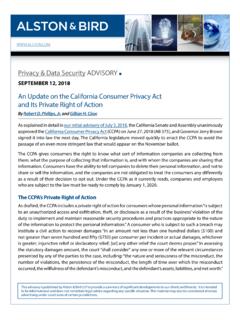Transcription of Data Security and Confidentiality Guidelines
1 National Center for HIV/AIDS, Viral Hepatitis, STD, and TB Prevention data Security and Confidentiality Guidelinesfor HIV, Viral Hepatitis, Sexually Transmitted Disease, and Tuberculosis Programs:Standards to Facilitate Sharing and Use of Surveillance data for Public Health ActionData Security and Confidentiality Guidelinesfor HIV, Viral Hepatitis, Sexually Transmitted Disease, and Tuberculosis Programs:Standards to Facilitate Sharing and Use of Surveillance data for Public Health Action Suggested Citation: Centers for Disease Control and Prevention. data Security and Confidentiality Guidelines for HIV, Viral Hepatitis, Sexually Transmitted Disease, and Tuberculosis Programs: Standards to Facilitate Sharing and Use of Surveillance data for Public Health (GA): Department of Health and Human Services, Centers for Disease Control and Prevention; 2011 This report was prepared bySecurity and Confidentiality Guidelines Subgroup of CDC s NCHHSTP Surveillance Work Group: Patricia Sweeney, Sam Costa; Division of HIV/AIDS PreventionHillard Weinstock , Patrick Harris, Nicholas Gaffga; Division of STD PreventionKashif Iqbal; Division of Viral HepatitisLilia Manangan, Suzanne Marks; Division of TB EliminationGustavo Aquino; Office of the Director, NCHHSTPThis publication lists non-federal resources in order to provide additional information to consumers.
2 The views and content in these resources have not been formally approved by the Department of Health and Human Services (HHS). Listing these resources is not an endorsement by HHS or its of Contents I. Executive Summary ..1 II. Introduction .. 2 III. About this Document .. 5 IV. Using this Document .. 5 V. Benefits, Risks, and Costs of Sharing data and Maintaining Security and Confidentiality .. 9 VI. Guiding Principles for data Collection, Storage, Sharing, and Use to Ensure Security and Confidentiality ..10 VII. Standards for data Collection, Storage, Sharing, and Use to Ensure Security and Confidentiality ..12 VIII. References ..35 IX. Acknowledgements ..38 Appendix A. Glossary ..39 Appendix B. Checklists for Assessment of data Security and Confidentiality Protections ..43 Appendix C. data Sharing Scenario ..55 Appendix D. Sample Certification Statement ..57 Appendix E. Suggested Outline for a Policy on data Confidentiality , Security , Sharing and Use.
3 59 Appendix F. Guidelines for the Use of Facsimile Machines ..61 Appendix G. Ensuring data Security in Nontraditional Work Settings ..631I. Executive Summary A goal of CDC s National Center for HIV/AIDS, Viral Hepatitis, STD, and TB Prevention (NCHHSTP) is to strengthen collaborative work across disease areas and integrate services that are provided by state and local programs* for prevention of HIV/AIDS, viral hepatitis, other sexually transmitted diseases (STDs), and tuberculosis (TB). A major barrier to achieving this goal is the lack of standardized data Security and Confidentiality procedures, which has often been cited as an obstacle for programs seeking to maximize use of data for public health action and provide integrated and comprehensive services. Maintaining Confidentiality and Security of public health data is a priority across all public health programs. However, policies vary and although disease-specific standards exist for CDC-funded HIV programs, similarly comprehensive CDC standards are lacking for viral hepatitis, STD, and TB prevention programs.
4 Successful implementation of common data protections in state and local health departments with integrated programs suggest implementation of common data Security and Confidentiality policies is both reasonable and feasible. These programs have benefited from enhanced successful collaborations citing increased completeness of key data elements, collaborative analyses, and gains in program efficiencies as important benefits. Despite the potential benefits, however, policies have not been consistently implemented and the absence of common standards is frequently cited as impeding data sharing and use. Adoption of common practices for securing and protecting data will provide a critical foundation and be increasingly important for ensuring the appropriate sharing and use of data as programs begin to modify policies and increasingly use data for public health action. This document recommends standards for all NCHHSTP programs that, when adopted, will facilitate the secure collection, storage, and use of data while maintaining Confidentiality .
5 Designed to support the most desirable practices for enabling secure use of surveillance data for public health action and ensuring implementation of comprehensive evidence-based prevention services, the standards are based on 10 guiding principles that provide the foundation for the collection, storage, and use of these public health data . They address five areas: program policies and responsibilities, data collection and use, data sharing and release, physical Security , and electronic data Security . Intended for use by state and local health department disease programs to inform the development of policies and procedures, the standards are intentionally broad to allow for differences in public health activities and response across disease programs. The standards, and the guiding principles from which they are derived, are meant to serve as the foundation for more detailed policy development by programs and as a basis for determining if and where improvements are needed.
6 The process includes seven main steps: designating an overall responsible party; performing a standards-based initial assessment of data Security and Confidentiality protections; developing and maintaining written data Security policies and procedures based on assessment findings; developing and implementing training; developing data -sharing plans or agreements as needed; certification of adherence to standards; and *State and local is inclusive of state, tribal, local and territorial health departments and agencies. 2performing periodic reviews of policies and procedures. NCHHSTP-funded programs will also be required to verify their adherence to the standards through submission of certification statements. CDC will work with state and local health departments to monitor the implementation of the Guidelines and evaluate their impact on securing data , facilitating data use, and increasing program document reflects the combined efforts of NCHHSTP s Surveillance Workgroup members, composed of surveillance leaders from NCHHSTP s Division of HIV/AIDS Prevention (DHAP), Division of Viral Hepatitis (DVH), Division of STD Prevention (DSTDP), and Division of TB Elimination (DTBE).
7 The work was informed by consultation with state and local public health leaders and public health organizations representing HIV, viral hepatitis, STD and TB disease disciplines (see Acknowledgements section). The document supersedes previously published Security and Confidentiality Guidelines for HIV surveillance and establishes data Security and Confidentiality standards for viral hepatitis, STD, and TB. Establishment of these standards that apply to all surveillance activities in all of the Center s divisions will facilitate collaboration and service integration among NCHHSTP-funded programs with minimal risk of inappropriate release of confidential, identifiable surveillance data or misuse of those data in pursuit of legitimate public health purposes. II. IntroductionThe true value of surveillance is measured by its impact on public health action and Public health agencies at all levels have broad authority to collect, store, and use personal health information to identify, report, and control health threats and to plan, implement, and evaluate public health programs and services.
8 The public trusts that any personal or confidential information collected as part of public health activities will be held securely and confidentially and will be used for legitimate public health purposes. Although protections exist through various laws, policies and procedures, these protections vary across jurisdictions2-4 and sometimes even within public health goal of CDC s National Center for HIV/AIDS, Viral Hepatitis, STD, and TB Prevention (NCHHSTP) is to strengthen collaborative work across disease areas and integrate services that are provided by programs for prevention of HIV/AIDS, viral hepatitis, other sexually transmitted diseases (STDs), and tuberculosis (TB).6 A major barrier to achieving this goal is the lack of standardized data Security and Confidentiality procedures, which has often been cited as an obstacle for programs seeking to maximize use of data for public health action and provide integrated and comprehensive Although disease-specific standards exist for CDC-funded HIV programs,8,9 similarly comprehensive CDC standards are lacking for viral hepatitis, STD, and TB prevention programs.
9 3 CDC established data Security and Confidentiality Guidelines for CDC-funded HIV surveillance programs in state and local* health departments in 19988 and updated the Guidelines in The Guidelines emphasize the protection of surveillance data and prohibit HIV surveillance programs from sharing data with programs that lack equivalent data Security and Confidentiality protections. These restrictions on data sharing had the unintended consequence of inhibiting the ability of some local health departments to link clients to appropriate treatment and prevention ,10In 2008, CDC published updated recommendations for programs providing partner services for HIV, syphilis, gonorrhea, and chlamydial infections. The document includes recommendations related to record keeping, data collection, data management, and data Security that were based on previously published HIV surveillance The partner services recommendations encourage data linkage and sharing between public health service-provision prevention programs and disease-reporting surveillance systems.
10 The recommendations suggest that sharing of individual-level surveillance data can help facilitate the timely provision of partner services but also underscore the need for well-defined Security and Confidentiality policies and procedures. Despite the potential benefits, however, these have not been consistently addition, CDC cooperative agreements with TB programs require that policies and procedures must be in place to protect the Confidentiality of all TB surveillance case reports and files. TB programs should also collaborate with HIV/AIDS programs to conduct at least annual TB and AIDS registry matches to ensure completeness of reporting of HIV and TB coinfected patients to both surveillance systems. However, this collaboration has been hampered by perceived differences in policies and procedures to protect HIV test results. This document does not specify details of how, what or when data should be shared but rather establishes standards of data protection across programs that should be in place.



















